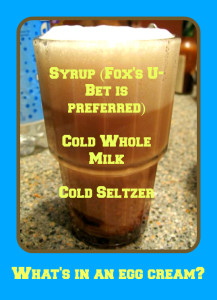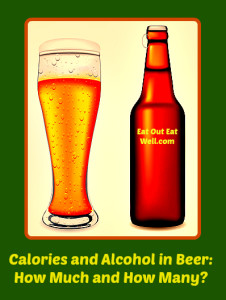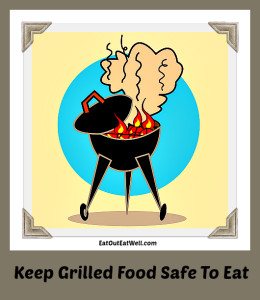
[Source: Today I found out]
Food for Fun and Thought
So, What’s An Egg Cream?
 It isn’t made with eggs or cream. It has a complex taste – sort of like what’s left over in the bottom of your glass after you eat the ice cream out of an ice cream soda. You can’t find bottled egg creams – although companies have tried – because the ingredients separate, the fizz disappears, and the taste just isn’t the same.
It isn’t made with eggs or cream. It has a complex taste – sort of like what’s left over in the bottom of your glass after you eat the ice cream out of an ice cream soda. You can’t find bottled egg creams – although companies have tried – because the ingredients separate, the fizz disappears, and the taste just isn’t the same.
A recent article got me thinking about egg creams. I’ve made hundreds of them. My parents owned an old-fashioned soda fountain in Flushing, Queens (NY) – the kind with a long counter with revolving stools. We sold lots of fizzy drinks: thousands of egg creams, ice cream sodas, cokes and cherry cokes (vanilla cokes, too), and for those with upset stomachs, old fashioned bromo seltzers that you poured from glass to glass to really get a fizz going.
Historically, fizzy water (essential to an egg cream), was considered medicinal. The first commercial carbonators were found in pharmacies and pharmacists added mineral salts to water to mimic those found in naturally carbonated water. To make the fizzy stuff more tasty and profitable they started flavoring it with sweet syrups (and in some cases — a long time ago — some not so benign stuff like cocaine and alcohol).
What Happened To Soda Fountain Drinks?
There is some speculation that the bottle cap was the death knell for soda fountain drinks. When fizzy soda in a bottle could be conveniently bought at the gas station, soda mixed at the fountain lost some of its appeal, although, in my experience, people would come for conversation and camaraderie along with the soda.
Lately there’s been a resurgence of soda fountain drinks – many made with home-made syrups, fizzy water, herbs, and organic milk when the drink calls for it.
So, What’s An Egg Cream?
An egg cream is sweet and fizzy and initially was made almost exclusively in New York City. Most people think chocolate is the only flavor— a lot of New Yorkers insist on iconic Fox’s U-Bet Chocolate Syrup — but they can be made with vanilla or strawberry syrup, too.
Interestingly, some egg cream purists insist on using only Kosher For Passover Fox’s U-Bet Chocolate Syrup and not the regular Fox’s U-Bet, made in Brooklyn year round. The reason? Regular U-Bet is made with sugar and/or corn syrup but the original Fox’s U-Bet, made only with refined sugar, is only produced during Passover.
Most of the “new” makers of egg creams – as well as “old-timers” — agree that only cold seltzer made from a carbonator with taps — not from the push button soda gun you see behind bars or from bottles of club soda — gives the popping and lively bubbles that make the best drinks. Our fountain had big gas tanks to provide the seltzer water – which inevitably needed changing (by my father) during a very busy lunch hour!
We always used the iconic coke glass for our egg creams and that’s what I remember an egg cream being served in when I ordered it in other places, too. An egg cream needs to be drunk quickly – gulping is okay – because it’ll lose its fizzy head if it sits too long.
Ingredients for a home made egg cream:
- Cold whole milk (low fat or skim won’t foam well)
- Cold seltzer: a soda siphon with a cartridge that carbonates water is great – otherwise, use very cold seltzer
- Chocolate (or vanilla or strawberry) syrup
Preparation:
The Original Brooklyn Egg-Cream (from Fox’s U-bet)
- Take a tall, chilled, straight-sided, 8oz. glass
- Spoon 1 inch of U-bet Chocolate syrup into glass
- Add 1 inch whole milk
- Tilt the glass and spray seltzer (from a pressurized cylinder only) off a spoon, to make a big chocolate head
Drink up!
Calories and Alcohol In Beer: How Many and How Much?
 Have you ever noticed that alcohol doesn’t fill you up the way food does? Here’s why: it doesn’t register as “food” in your GI tract or your brain.
Have you ever noticed that alcohol doesn’t fill you up the way food does? Here’s why: it doesn’t register as “food” in your GI tract or your brain.
The bad news: it doesn’t fill you up but it does have calories — 7 calories a gram – more than carbs and protein which have 4 calories a gram and fat which has 9. So, even though it might not seem as though you’re putting calories into your body, you could be taking in a lot of calories and not feel stuffed (perhaps drunk, but not stuffed).
How Much Alcohol is in Beer?
A standard drink in the United States is equal to 14.0 grams (0.6 ounces) of pure alcohol. Generally, that’s the amount of pure alcohol found in:
- 12 ounces of beer
- 8 ounces of malt liquor
- 5 ounces of wine
- 1.5 ounces or a “shot” of 80-proof distilled spirits or liquor (e.g., gin, rum, vodka, or whiskey)
Is Beer or Wine Safer to Drink than Liquor?
No. Don’t be fooled. One 12-ounce beer has about the same amount of alcohol as one 5-ounce glass of wine, or 1.5-ounce shot of liquor. It’s the amount of alcohol consumed that affects a person most, not the type of alcoholic drink.
How Many Calories Are in Your (12 ounce) Beer Bottle?
- Sierra Nevada Bigfoot Ale: 330 calories
- Samuel Adams Boston Lager: 180 calories
- Guinness Extra Stout: 176 calories
- Pete’s Wicked Ale: 174 calories
- Harpoon IPA: 170 calories
- Heineken: 166 calories
- Killian’s Irish Red: 163 calories
- Long Trail: 163 calories
- Molson Ice: 160 calories
- Samuel Adams Brown Ale: 160 calories
- Budweiser: 144 calories
- Corona Light: 105 calories
- Coors Light: 102 calories
- Heineken Light: 99 calories
- Budweiser Select: 99 calories
- Miller Light: 96 calories
- Amstel Light: 95 calories
- Anheuser Busch Natural Light: 95 calories
- Michelob Ultra: 95 calories
- Miller MGD 64: 64 calories
- Beck’s Premier Light: 64 calories
Calorie Saver:
Analyze your beer choice. Since there’s a very wide variation in the calories in beer, can you be satisfied with one of the lower calorie brews?
Road trip: is there one in your future?

The Summer issue of Eat Out Eat Well Magazine is ready to help you eat well when you’re in the car or grabbing some food at rest stops or roadside diners.
Get it now from iTunes or the Google Play Store for $1.99 an issue or $4.99 for a yearly subscription (four seasonal issues).
A Dozen Ways To Keep Grilled Food Safe To Eat
 Summer means grilling and barbecue for lots of people. It’s hard to resist juicy burgers, sizzling steaks, fish seared to perfection, and frankfurters crackling and popping and screaming for mustard and relish or sauerkraut.
Summer means grilling and barbecue for lots of people. It’s hard to resist juicy burgers, sizzling steaks, fish seared to perfection, and frankfurters crackling and popping and screaming for mustard and relish or sauerkraut.
The food may taste great, but picnics, barbecues, and grilling can create the perfect environment for the bacteria that already reside in food to rapidly multiply and become the cause of a foodborne illness.
It’s really important to follow safe food handling rules when you’re cooking perishable foods like meat, poultry, and seafood and Unfortunately, it’s way too easy to get a little lax about following food handling rules when the grill takes center stage.
Some Grilling Guidelines
- Always wash your hands with soap and water before and after you handle the food. Did you pick up the raw burger or the piece of fish or chicken with your fingers to put it on the grill?
- When you marinate your food, let the food sit in the marinade in the refrigerator — not the counter — or even worse, in the sun next to the grill. Don’t use the marinade that the raw meat or poultry sat in on the cooked food. Instead, reserve part of unused marinade to baste with or to use as a sauce.
- Get those coals hot. Preheat the coals on your grill for 20 to 30 minutes, or until they are lightly coated with ash. If you’re using a gas grill, turn on the grill so it has enough time to thoroughly heat up.
- When the food is cooked, don’t put it on the same platter that you used to carry the raw food out to the grill. Ditto for the tongs and spatula unless they’ve been washed first in hot, soapy water. Reusing without washing can spread bacteria from the raw juices to your cooked or ready-to-eat food. Bring a clean platter and utensils with you to the grill and remove the ones that the raw food has been on – it’s too easy to mistakenly reuse the raw food ones.
- When grilled food is “ready” keep it hot until it’s served by moving it to the side of the grill rack, just away from the coals or the gas burner. This will keep it hot but prevent it from overcooking. If you reheat food, make sure it reaches 165°F.
- Cook only the amount of food that you think people will eat. It’s easy to cook more, but it’s a challenge to keep leftovers at a safe temperature. Throw out any leftovers that haven’t stayed within the safe temperature range.
- Use a food thermometer (make sure you have one at home and one to pack for grilling at picnics) to be certain that the food reaches a safe internal temperature. The FDA recommends:
- Steaks and Roasts: 145 degrees F (medium rare), 160 degrees F (medium)
- Fish: 145 degrees F
- Pork: 145 degrees F
- Ground beef: 160 degrees F
- Egg dishes: 160 degrees F
- Chicken breasts: 165 degrees F
- Whole poultry: 165 degrees F
- Shrimp, lobster, and crabs: cook until pearly and opaque
- Clams, oysters, and mussels: cook until the shells are open
HCAs and PAHs: Two Dangerous Compounds That Can Form
Unfortunately, two types of cancer causing compounds can increase or form in some foods that are grilled or cooked at high heat.
Heterocycline amines (HCAs) increase when meat, especially beef, is cooked with high heat by grilling or pan-frying. HCAs can damage DNA and start the development of cancer. Most evidence connects them to colon and stomach cancer, but they may be linked to other types of cancer, too.
Polycyclic aromatic hydrocarbons (PAHs) increase with grilling because they form in smoke and can get deposited on the outside of your meat.
Five Things You Can Do to Decrease HCAs and PAHs:
- Cook or fry at lower temperatures to produce fewer HCAs. You can turn the gas down or wait for charcoal’s low-burning embers.
- Raise your grilling surface up higher and turn your meat very frequently to reduce charring, which is highly carcinogenic. Grilling fish takes less cooking time and forms fewer HCAs than beef, pork and poultry.
- Marinate your meat. According to the American Institute for Cancer Research, marinating can reduce HCA formation by as much as 92 to 99%. Scientists think that the antioxidants in marinades help block HCA formation.
- Add some spices and rubs. Rosemary and turmeric, for example, seem to block up to 40% of HCA formation because of their antioxidant activity. A study by Kansas State University found that rubbing rosemary onto meat before grilling greatly decreased HCA levels. Basil, mint, sage, and oregano may be effective, too.
- Select leaner cuts of meat and trim excess fat to help reduce PAHs. Leaner cuts drip less fat – and dripping fat causes flare-ups and smoke which can deposit PAHs on your food.
Iced And Frozen Coffee Drinks: Are They Coffee, Snacks, Or Dessert?
 When the weather heats up, the coffee drinks tend to cool down. Unfortunately, some iced and frozen coffee drinks – whether they’re from a coffee shop or from a can — can really bump up your calories and fat grams.
When the weather heats up, the coffee drinks tend to cool down. Unfortunately, some iced and frozen coffee drinks – whether they’re from a coffee shop or from a can — can really bump up your calories and fat grams.
Calories in Some Iced And Frozen Coffee Drinks
Note: all info (with the exception of Burger King) is for a 16 ounce cup.
- Starbucks Mocha Frappuccino with whipped cream, 16 ounces (grande): 400 calories, 15 g fat (9 g saturated), 64g carbohydrates.
- Starbucks Mocha Light Frappuccino with nonfat milk, 16 ounces (grande): 130 calories, 0.5g fat, (0 g saturated), 28g carbohydrates.
- Iced Caffe Latte with nonfat milk, 16 ounces (grande): 90 calories, 0g fat, 13g carbohydrates.
- Dunkin’ Donuts Coffee Coolata made with whole milk, 16 ounces (small): 240 calories, 4 g fat (2.5 g saturated), 50g carbohydrates
- Dunkin’ Donuts Vanilla Bean Coolatta, 16 ounces (small): 420 calories, 6g fat (3.5g saturated), 92g carbohydrates
- Dunkin’ Donuts Iced Caramel Mocha Latte with milk, (large): 450 calories, 12g fat (7g saturated), 73g carbohydrates
- Dunkin’ Donuts Iced Latte made with skim milk, 16 ounces (small): 80 calories, 0g fat, 13g carbohydrates
- Baskin Robbins Cappuccino Blast Mocha, 16ounces (small): 400 calories, 13g fat (9g saturated), 65g carbohydrates
- McDonald’s McCafé Iced Caramel Mocha, 16 ounces (medium) made with whole milk and whipped cream: 300 calories, 14g fat (8g saturated), 36g carbohydrates
- Burger King: Iced Seattle’s Best Coffee Mocha, 22 ounces (medium): 260 calories, 3.5g fat (2.5g saturated), 54g carbohydrates
Calorie Savers:
- Ditch the whipped cream.
- Swap full fat or 2% milk for 1% or skim.
- Watch the sugar: ask for one pump instead of two or sugar free syrup, add non-calorie sweetener instead of sugar, or don’t sweeten at all.
- Change the size of the drink that you order: instead of a venti or an extra large, order a grande or large – or drop down to a tall, medium, or even a small-sized drink.
- If you have a two a day (or more) habit – like a coolata in the morning and a frappuccino in the afternoon – substitute a plain coffee or iced tea (easy on the milk and sugar), or even a latte with nonfat milk for one of those choices.
- Order plain iced coffee or even an iced Americano (almost no calories for 16 ounces) and doctor it with non-caloric sweetener and skim milk. You’d even come out ahead if you use controlled amounts of sugar and a bit of half and half. Or have an iced brewed coffee with classic syrup: a 12 ounce cup has 60 calories.